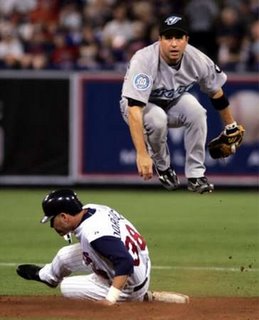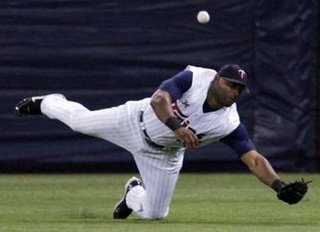August 13, 2006
Notes From the Weekend
Last Wednesday night, Justin Morneau become the first Twins hitter since 1987 to have a 30-homer season, smacking a game-winning blast off Tigers reliever Joel Zumaya. The dramatic win propelled the Twins to the top of the Wild Card standings, a half-game ahead of the White Sox and 1.5 games ahead of the Red Sox.
After being able to look down at only the Royals in the league standings earlier this season, the Twins took two out of three games on the road from arguably baseball's best team to put themselves into the driver's seat for a postseason spot. It was one of the most amazing in-season turnarounds in recent memory, with a pathetic 25-33 start followed by a startling 42-13 run.
Having worked all that time just to dig themselves out of an early-season hole, what did the Twins do once they climbed out? They welcomed the free-falling Blue Jays to the Metrodome for a four-game series and proceeded to lose the first three games by a combined score of 16-1. Brad Radke and Jason Tyner helped avert disaster with a win yesterday afternoon, but the damage had been done.
While the Twins were losing three out of four home games to a team that came into the series 15-20 since June 1, the White Sox pulled off a three-game sweep of the Tigers and the Red Sox bashed their way to a three-game sweep of the Orioles. In the span of four measly days, the Twins went from leading the Wild Card race to looking up at three teams in the standings:
WILD CARD W L WIN% GB
Chicago 70 46 .603 ---
Boston 68 48 .586 2.0
Minnesota 68 49 .581 2.5
Here are some notes from a weekend the Twins will probably look back on in disgust should they fall a game or two short of the playoffs ...
While hitting into double plays hasn't seemed like nearly as big an issue this season, the Twins have been just as bad when it comes to doing so:
YEAR DP/G DP%
2005 1.15 17.1
2006 1.33 16.6
As difficult as it may be to believe, the Twins have actually hit into about 15 percent more double plays per game this season. However, you can't hit into a double play unless there's at least one runner on base, which is why looking at raw double-play totals is often misleading. An increase in double plays may simply mean an increase in baserunners, which is certainly the case with the Twins this season.
With that said, the Twins have still managed to hit into a double play 16.6 percent of the time in what Baseball Prospectus calls a "double-play opportunity." That's the worst percentage in baseball by a relatively large margin and the Twins also ranked dead last in 2005. Why do the Twins hit into so many double plays? There are two main reasons.
With little in the way of home-run power, the Twins' offense is built upon hitting singles. That's been the case for a while now, but has become especially true this season with Luis Castillo, Nick Punto, Jason Bartlett, Jason Tyner, and Joe Mauer taking prominent roles in the lineup. The Twins rank 28th among MLB teams in homers, but lead baseball in singles.
In fact, the Twins have at least 10 percent more singles than 20 of the other 29 teams. Along with a fair number of walks, that leads to a ton of runners standing on first base. And since that situation is what typically leads to a double play, it puts the Twins at constant risk of hitting into one. Of course, that doesn't explain why they comply so often.
With so many singles-hitting speedsters, you'd expect the Twins to avoid double plays much of the time. While that certainly helps, a more important factor is that the team hits the ball on the ground a huge percentage of the time. Along with leading baseball in singles, the Twins have also led MLB in ground ball-to-fly ball ratio for the past two seasons.

Add it all up and the Twins have built sort of a "perfect storm" for hitting into double plays. They hit tons of singles, draw a decent number of walks, don't often clear those runners off the bases with homers, and put the ball on the ground more than any other team. Throw in some bad baserunning and it's no wonder they're hitting into 1.33 double plays per game.
DP%
Jason Kubel 32.6
Rondell White 27.9
Lew Ford 26.7
Jason Tyner 23.8
Juan Castro 23.1
Shannon Stewart 22.9
Mike Redmond 22.1
Joe Mauer 18.1
Torii Hunter 16.5
Tony Batista 14.3
Luis Castillo 12.1
Jason Bartlett 11.4
Justin Morneau 11.0
Michael Cuddyer 8.8
Nick Punto 8.6
Mauer's double-play percentage of 18.1 is still poor, but nowhere near the worst on the team. That distinction falls to Jason Kubel at 32.6 percent, and Mauer isn't among the seven Twins hitters who have hit into a double play over 20 percent of the time. The most surprising member of that group is Tyner, whose incredible speed should seemingly keep him from being doubled up that often.
The bottom of the list is filled with fast guys like Castillo, Bartlett, and Punto, along with the fly-ball heavy Morneau. Even more than Tyner having one of the worst double-play percentages on the team, Michael Cuddyer having one of the best is shocking. Cuddyer hit into a double play 25 percent of the time last season, but has cut that number all the way to 8.8 percent this year.
Garza failed to record another strikeout, nine of the next 15 batters reached base, and two of them hit the ball over the fence. Once the dust settled, Garza left with his tail between his legs and the following pitching line:
IP H R ER BB SO HR PIT
2.2 8 7 7 2 2 2 67
That's obviously an ugly debut, but there were still several positive things to be taken from the game. For one thing, his fastball was electric and his breaking stuff, while not thrown particularly often or with much consistency, was plenty impressive at times. In other words, Garza looked great on individual pitches, but the collective effort was very uneven and shaky.
He looked incredibly nervous nearly the entire time, so much so that his actual delivery to the plate seemed out of whack. Garza appeared to be telegraphing his off-speed pitches by slowing down his delivery and changing his arm angle, which is surely why he had so much trouble finishing off at-bats once he got ahead in the count.
Garza threw 10 first-pitch strikes and managed to get two-strike counts on eight hitters. Unfortunately, the Blue Jays had little problem making solid contract even after falling behind in the count and Garza was able to get the all-important third strike just one-fourth of the time. Interestingly, he threw just 15 balls out of 62 total pitches, yet walked Eric Hinske on four straight pitches leading off the third inning.
I expected more from Garza, but his debut was probably what should have been expected from a 22-year-old pitcher who was at Single-A a couple months ago. He flashed electric stuff, but showed a lot of nerves, some inconsistent mechanics, and the inability to finish off major-league hitters. Given a chance to settle in and work with pitching coach Rick Anderson, I expect Garza to improve quickly.

I haven't seen enough of post-injury Hunter to say exactly how far he's dropped, but it's clear that he's no longer able to make many of the plays he used to make on a fairly routine basis. Hunter returned from the DL before his latest foot injury had healed and last year's broken ankle has continued to give him problems, so perhaps an offseason of rest will restore some of his lost range.
However, that's not going to help the Twins down the stretch and it's yet another mark against bringing Hunter back for $12 million in 2007. The notion of Hunter as "the face of the Twins" was silly to begin with and surely expired a while back, and those in favor of picking up his 2007 option won't have much else to cling to if he's no longer one of the team's top hitters or an elite defensive center fielder.
After a decade of marveling at Hunter's defense, it's difficult to watch him limp around right now. It's shocking to see him not come up with the catch when he dives for a ball or not get there in time to cut a ball off in the gap, and I can't remember ever seeing him give up on this many deep fly balls in order to play them off the fence.
After shutting the Blue Jays out for seven innings to help the Twins avoid a sweep, Radke is now 8-2 with a 2.66 ERA in 15 starts since late May.For the past four days, Brad Radke washed his hair with his left hand and avoided throwing a baseball with his right. "Sometimes I make a sudden movement with my right arm," he said, "and it brings me to my knees."
[...]
"Seriously, I can't even play catch," he said. "Maybe the day before a start, I might feel a little better, where I can throw maybe five throws, from 40 feet at most, before it really starts to hurt."
So how does he throw 100 pitches to big-league hitters? "I guess it's adrenaline," he said. "And what we're going through here, fighting for a playoff spot. I'm doing everything I can."

